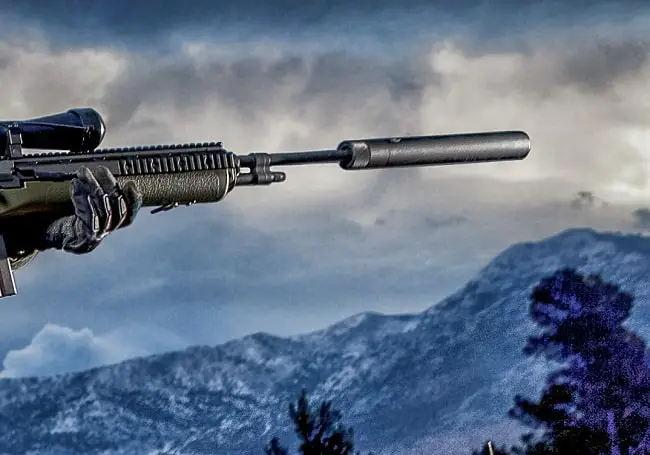I own both a 9mm and a 308. I’m looking into getting a suppressor, but want it to fit both guns. Here’s what I’ve learned so far.
A suppressor made for a 380 is designed to work with a bullet that is .308 inches in diameter. A 9mm bullet is .357 inches. Most 308 suppressors are not designed large enough to fit the 9mm bullet, which is almost 5 calibers larger. However, you can fit a 9mm suppressor on a 308
Suppressors are becoming more mainstream than ever for gun owners. most people are realizing that they are not scary, should not be restricted, and are very practical tools. If you’ve never fired a suppressed gun, you are missing out. Here’s what you need to know about them.
Suppressors are caliber specific
Suppressors, sometimes erroneously called silencers, are designed to fit a particular caliber, or sometimes a small range of calibers. Suppressors are made with an amount of overbore, which means there’s extra space around the bullet. This is for a few practical reasons and safety issues.
The first is the possibility of a suppressor being mounted non-concentric with the bore. It happens more than you might think. If the threads on the muzzle were not cut on a concentric axis with the bore, the suppressor will not screw on in line with the bore.
Also, there are cases where the rifling is cut perfectly square with the muzzle, but the bore wasn’t drilled straight into the barrel so although the whole thing looks perfectly straight in line, the bore is cut on s alight angle and will throw the bullet off of center.
That’s one set of issues. The suppressor needs to be able to safely operate with in a safe working tolerance. That means a suppressor that’s a little bit oversized will have less chance of messing up the flight your bullet off center as it flies through the suppressor.
Safety in the Design of a Suppressor
No company wants to make a suppressor that might blow up during use. They are all safe to use, except maybe those “fuel filters” sold on whish.com. please, don’t buy those. If the ATF doesn’t get you first, it might low like a hand grenade.
Designing the suppressor with a bit of an overbore creates a noisier gunshot, but reduces the pressure in the suppressor. Some suppressors probably would blow up if they were the same internal diameter as the barrel. Plus, suppressors get dirty. As gunk builds up, the hole gets smaller.
Over bore allows it to safely function even when something starts going wrong, like if you forgot to clean it.
Multi-caliber Suppressors do exist
You should never take a caliber specific suppressor and put it on a large caliber gun. Even if it’s only a hundredth of an inch larger, you are reducing the safe working tolerance designed into it. don’t do it. period.
Now, there have been companies who make a .357 caliber suppressor and sell it as two products. They mark half of them as a 9mm suppressor (.357) and the other half of the lot are marked as a .308 suppressor. It’s not technically cheating, but it almost is.
If you really want to know, take a set of calipers and measure the center bore of a suppressor. Apparently, nobody does this because I have scoured the internet for hours on my usual source forums and websites and got almost nothing.
Some suppressors are sold as multi-caliber. basically, the manufacturer takes a suppressor designed for a specific caliber, and says you can also use it on smaller calibers. And the truth is, you can safely do so. But at a reduced effectiveness.
If a suppressor has too much overbore, it will not adequately reduce the volume of the gun shot. It won’t be a very good suppressor. The most effective suppressors have only a little overbore. You can put a 45 acp suppressor on a 9mm, and it will work some, but it will be quieter on the 45 acp.
Using a Suppressor on a Smaller Caliber is common.
Most people with suppressors u se them on more than one gun. more often than not, they get used on more than one caliber, and that’s totally fine. A normal saying is “get a suppressor for your largest handgun and one for your largest rifle”. the idea is that you can screw it on to smaller guns and still get some function. It’s a one size sort of fits most philosophy.
Mainly, this comes from the fact that in the US, it costs an additional $200 and about a year wait on the paperwork to get a suppressor. All that because although cars need to have mufflers, guns aren’t allowed to because you have to hear it coming in case a criminal uses a gun.
Although nobody cares if a criminal drives a quiet car that you can’t her coming. Remember, quite cars are as necessary for civil life, as loud guns are. The whole thing is stupid, but whachya gonna do?
Anyway, you can always use a suppressor on a smaller diameter bullet than it was designed for, but a caliber specific one works best.
Several companies make suppressor adapters so a suppressor with the larger thread size will fit on a smaller muzzle. The two standard thread sizes are 1/2×28 and 5/8×24. several companies have proprietary sizes. check the manufacturer’s specs for your thread size.
As always, live long and prosper, and MOLON LABE!

